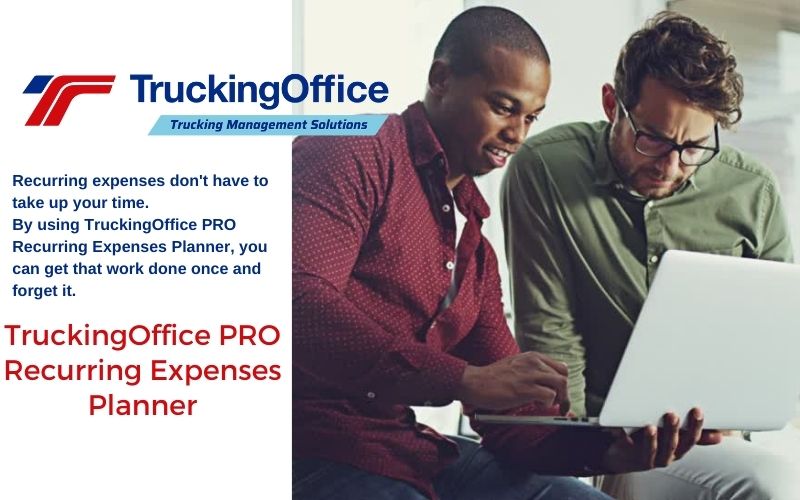When you run a trucking business, you’ve got expenses that you pay consistently. That’s a good thing. You know the bottom line that your business needs to break even. If you’re hauling a regular load for a customer, you can look at your records and know what the expenses are for that load. Recurring expenses don’t have to take up your time, however. By using TruckingOffice PRO Recurring Expenses Planner, you can get that work done once and forget it.
Recurring Expenses
Fixed expenses are expenses you pay per month regardless of number of miles driven.
Recurring fixed expenses
- insurance
- loan payments
- software/smartphone/internet access
- professional services such as an accountant or a bookkeeper
- HVUT
- rent for storage, mortgage payments
- training
If you’ve got a cleaning service or a lawn-care/property management contractor, then you could add those to your list. Most of these items are for the business, not broken down per load.
If you have a regular lane, you can also track those recurring expenses, for example
- tolls
- permits
- truck weighing
It’s easy to forget regular recurring expenses. The driver might think, “I already put those in,” but what the driver is remembering is the last run, not this one. These expenses are important – too important to forget. Having them automatically entered into the accounting software makes it easier on the driver, on the bookkeeper, and on the manager.
Variable Expenses vs. Recurring Expenses
What’s the difference between variable and recurring expenses?
Simply put, variable expenses are those regular expenses that change in amount when they’re purchased. Fuel is the best example. Who knows what it’s going to cost to fill our tanks one day to the next?
Variable expenses per mile/load
- IRP, IFTA
- fuel
- tolls
- lumpers
What About Maintenance?
Maintenance can be both a variable and a recurring expense. (Nothing like making it more confusing, right?)
There are certainly some regular maintenance tasks that can be scheduled as a recurring expense. Oil changes are based on mileage, but it’s not hard with a regular load schedule to know when those will come up. It’s certainly a recurring expense and it may be regular, but can we predict how much it will cost with the current inflation?
Brake pads, oil changes – those are just two of the regular maintenance items that aren’t based on time but on mileage.
And we do NOT want to put a recurring item for emergency repairs!
Why Track Expenses in a Recurring Expense Planner
Average fixed expenses must be covered monthly. Every load has to contribute toward making the monthly minimum amount to keep the business open.
Sometimes we look at it like “how many miles per month do we have to haul freight to cover those costs?” Sometimes we look at the month and say “how much do we have to bring in to make a profit?”
Both of those perspectives are right. But the calculations are different.
That’s why TruckingOffice PRO provides multiple Trucker Stats™ to analyse the data that you’ve already added to TruckingOffice PRO trucking management software. The numbers are already in the system. We’ve programmed the calculations for you. All you have to do is select the report you want to see to how your company is doing with theCompany Overview Report.
This report can be generated monthly. There are 15 categories that his report lists.
-Revenue: this number is generated based on the information entered under “Fees/charges” including primary fee, accessory fees, and fuel surcharges.
-Revenue Paid: generated based on the invoices-the payments entered.
-Expenses: includes driver pay, invoice advance, fuel expenses and truck expenses.
-Profit: Total revenue minus expenses
-Load Count: Number of Loads within that month.
-Revenue Per Load: an average of all revenue for that month.
-Miles: The total number of loaded and empty miles
-Miler per load: the average of all miles within that month per load
-Revenue Per Mile: The total revenue divided by the miles.
-Revenue Per Loaded Mile: Total revenue divided by loaded miles only
-Expense Per Mile: Total expenses divided by the total miles
-Expense Per Loaded Mile: Total expenses divided by loaded miles only.
-Profit per mile: Profit (revenue minus expenses) divided by the total miles.
-Profit Per Loaded Mile: Profit (revenue minus expenses) divided by Total loaded Mile
Use the Recurring Expenses Planer in TruckingOffice PRO to automate a task that can too easily fall through the cracks.
Losing track of expenses may mean that you’re not getting reimbursed for expenses that that the shipper should pay. Losing track of expenses can cost you when your taxes come around. The Recurring Expenses Planner takes care of those regular expenses – reducing the amount of time spent managing them and tracking them so you have peace of mind!
Give TruckingOffice PRO a trial run for free!
When you’re ready to have confidence that your trucking business is successful and growing, use TruckingOffice PRO to manage your trucking business. Our free trial gives you access to everything (not hiding anything or limiting you like some “free” trials provide.) Take a look today at your trucking business with TruckingOffice PRO today!







Recent Comments